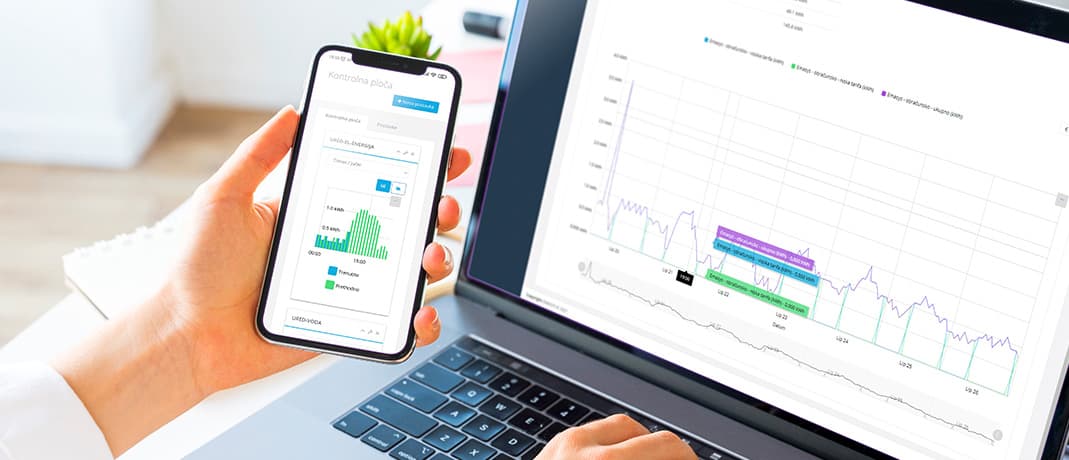What is Energy and Water Management?
Energy and water management is the proactive and continuous process of monitoring, controlling, and conserving energy and water in a district, organisation or specific facility with the aim of saving energy.
Energy management deals with existing sources of energy and actual energy and water consumption, which an organisation has complete control over.
Let’s take a look at the main steps of energy management, which are:
- Measuring your energy consumption
- Identifying opportunities to save energy
- Taking action to implement energy saving measures
- Tracking your progress and continuous monitoring
1. Measuring your energy consumption and collecting the data
Energy management starts with measuring your energy consumption and collecting the data to find out how your electricity, water, heating and cooling systems are working. Data collection will give you some baseline figures to look back on when you have taken actions to save energy. The more data you can get, and the more detailed it is, the better.
So where can you get your data from?
Energy data can come from your monthly utility bills, from manual meter checks or from automatic uploads from automatic metering devices. The first two sources of data lack the amount of detail necessary for effective energy management; weekly or monthly meter readings cannot show you how much energy or water you’re using at different times of the day, or on different days of the week, which is vital identifying consumption patterns and routine wastage at your site. Additionally, manual meter checks are time-consuming and error-prone.
Automatic metering devices that record, store and transmit energy and water consumption data at short regular intervals (every 15 minutes, 30 minutes or hour) are ideal. Data from these metering devices can be viewed and processed using a dedicated web application or software platform.
Automatic metering is essentially the first step towards effective energy management.
These devices and their corresponding applications or software will collect, monitor and process your consumption data and display it in easily-readable formats such as graphs and tables and give you a detailed analysis of your business’s consumption at different times of the day and on different days of the week. So what next?
2. Identifying opportunities to save energy
By analysing the data collected over the course of a day, a week and month you will most certainly be able to identify routine energy wastage and quantify energy-saving opportunities.
For instance, you might realise that a misconfigured or faulty HVAC (Heating, Ventilation and Air Conditioning) system has been heating or cooling an empty building every night and every weekend.
By comparing gas or fuel oil consumption with outdoor temperatures, you might realise that you are heating the building even when outdoor temperatures are high. Or you might witness the absurd (but alas known) phenomenon of heating a building at the same time as cooling it down.
You might wonder why electricity consumption is relatively high at night time and at weekends, only to discover upon a little further on-site investigation that lights and computers are being left on when everyone has left the building. Or in a manufacturing plant notice that at the same time each week your requirement for electricity is higher than the amount agreed with the utility provider and hence you are incurring additional charges for exceeding your contracted requirements.
3. Taking action to save energy
The next step once you’ve identified the where and how to save energy is to take action. The easiest and most cost-effective energy-saving measures typically require little or no capital investment. It doesn’t always involve complicated analysis or big capital investment.
Following on from the above examples, measures could include:
- Reconfiguring the settings of your building’s HVAC system or replacing its faulty control panel
- Turning off the heating system as soon as the temperatures outside permit
- Raising awareness of energy consumption among employees and encouraging energy efficient behaviours such as turning off lights and computers at the end of the day.
- Avoiding extra-load in peak time.
Furthermore, action could involve:
- Upgrading equipment (e.g. machinery, chillers, boilers) to a more energy efficient option,
- Replacing incandescent bulbs with LED energy efficient ones
- Insulating the building better by retrofitting the glazing in the windows
- Testing for water leakages (made obvious from the data collected) and getting them fixed
- Regular and efficient maintenance of machines and motors, which prevents extra loads, saves 15% of energy consumption and prevents break downs as well.
4. Tracking your progress
It is necessary to continue tracking your energy and water consumption in order to monitor your progress, verify savings, quantify the return on investment if you have invested in new equipment or other energy renewal projects, provide evidence that you’re meeting or making progress towards energy-saving targets and continue to respond quickly to abnormalities. New problems will arise over time, and old ones may reoccur. For instance, power cuts can cause timers to revert back to factory settings and keeping employees motivated requires ongoing attention.
It is also wise to implement an ongoing improvement schedule; use the savings made to finance more low-cost improvements. Keep saving, keep improving. With a proven track record of energy management, you will be able to secure the capital you need for bigger projects.
Energy management is the effective use of energy to maximise profit by minimizing costs.
In conclusion, energy management is about building a basis of information for good decision-making, and then acting on that information to reduce energy use. The right energy management system can automate the process from data collection to analysis and reporting which results in greater accuracy and better decisions.

